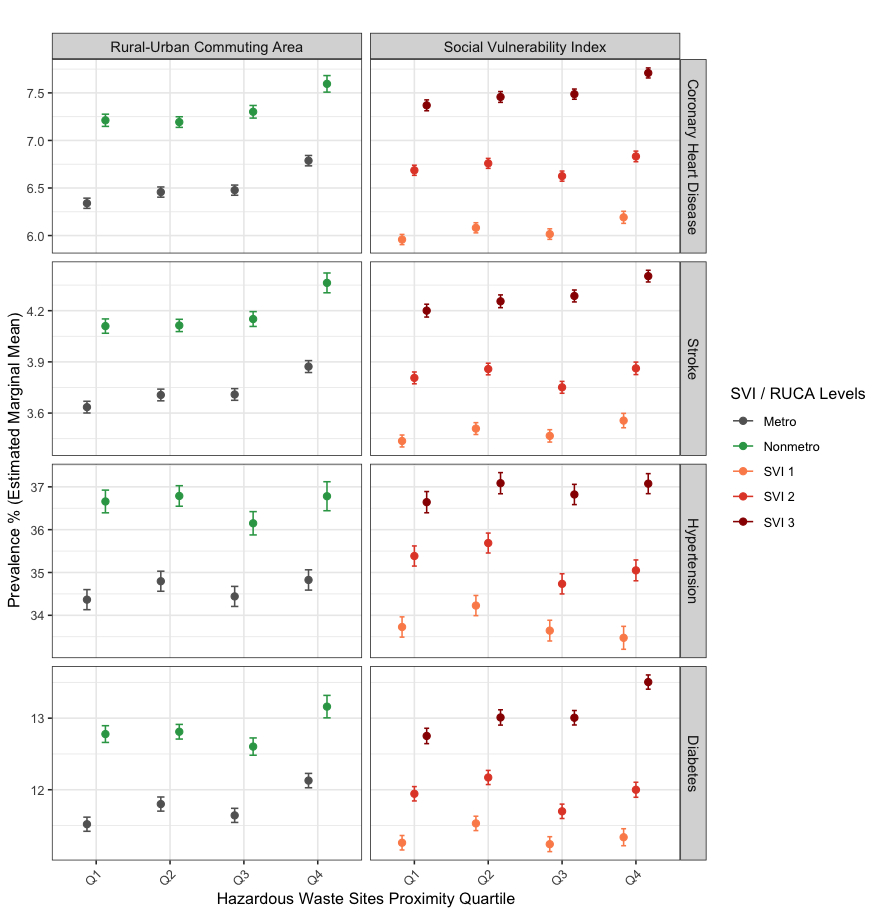Final ID: 071
Association Between Proximity to Hazardous Waste Sites and Cardiometabolic Diseases: Coronary Heart Disease, Stroke, Hypertension, and Diabetes
Abstract Body: Introduction:
Proximity to hazardous waste sites may increase cardiometabolic risk. However, differences in these associations by socioeconomic status and urban-rural residency is underexplored. We estimated the associations of proximity to hazardous waste sites with prevalence of coronary heart disease (CHD), stroke, hypertension, and diabetes, while exploring the moderating roles of the Social Vulnerability Index (SVI) and Rural-Urban status.
Hypothesis:
We hypothesized that neighborhoods closer in proximity to hazardous waste sites have an incrementally higher prevalence of the selected disease outcomes compared to neighborhoods furthest away.
Methods:
We used data from 57,845 (~70%) U.S. census tracts, creating a percentile-ranked score based on proximity to hazardous waste sites from the Environmental Justice Index, classified into quartiles (Q4 = closest). Prevalence of health outcomes were obtained from the Centers for Disease Control and Prevention (CDC) PLACES dataset, and SVI and Rural-Urban Commuting Area (RUCA) codes were obtained from the CDC and U.S. Department of Agriculture, respectively. A linear mixed-effects model assessed prevalence differences between quartiles, adjusting for percentages of uninsured, race/ethnicity minority, aged ≥65, and <17, with county-level random effects. We also evaluated the moderating role of SVI and urbanicity.
Results:
After adjustment, neighborhoods closest to hazardous waste sites (Q4) had a significantly higher prevalence of each of the cardiometabolic diseases when compared to Q1: CHD (0.35%; 95% CI, 0.33-0.38), Stroke (0.19%; 95% CI, 0.17-0.21), Hypertension (0.44%; 95% CI, 0.35-0.54) and Diabetes (0.48%; 95% CI, 0.43-0.53). The interaction term between SVI, RUCA, and our exposure was significant for all health outcomes (p<0.05), based on the Wald chi-square test. The magnitude of the associations were stronger in higher socially vulnerable neighborhoods (compared with low) (Figure 1). Although the prevalence of cardiometabolic diseases was higher in non-metro tracts, there was a weaker association with proximity to hazardous waste sites, compared to metropolitan tracts.
Conclusion:
These findings highlight the potential role of environmental factors in shaping community-level cardiometabolic health disparities. While individual inferences are limited by the study's ecological nature, the results emphasize addressing environmental and social vulnerabilities to promote health equity at a population level.
Proximity to hazardous waste sites may increase cardiometabolic risk. However, differences in these associations by socioeconomic status and urban-rural residency is underexplored. We estimated the associations of proximity to hazardous waste sites with prevalence of coronary heart disease (CHD), stroke, hypertension, and diabetes, while exploring the moderating roles of the Social Vulnerability Index (SVI) and Rural-Urban status.
Hypothesis:
We hypothesized that neighborhoods closer in proximity to hazardous waste sites have an incrementally higher prevalence of the selected disease outcomes compared to neighborhoods furthest away.
Methods:
We used data from 57,845 (~70%) U.S. census tracts, creating a percentile-ranked score based on proximity to hazardous waste sites from the Environmental Justice Index, classified into quartiles (Q4 = closest). Prevalence of health outcomes were obtained from the Centers for Disease Control and Prevention (CDC) PLACES dataset, and SVI and Rural-Urban Commuting Area (RUCA) codes were obtained from the CDC and U.S. Department of Agriculture, respectively. A linear mixed-effects model assessed prevalence differences between quartiles, adjusting for percentages of uninsured, race/ethnicity minority, aged ≥65, and <17, with county-level random effects. We also evaluated the moderating role of SVI and urbanicity.
Results:
After adjustment, neighborhoods closest to hazardous waste sites (Q4) had a significantly higher prevalence of each of the cardiometabolic diseases when compared to Q1: CHD (0.35%; 95% CI, 0.33-0.38), Stroke (0.19%; 95% CI, 0.17-0.21), Hypertension (0.44%; 95% CI, 0.35-0.54) and Diabetes (0.48%; 95% CI, 0.43-0.53). The interaction term between SVI, RUCA, and our exposure was significant for all health outcomes (p<0.05), based on the Wald chi-square test. The magnitude of the associations were stronger in higher socially vulnerable neighborhoods (compared with low) (Figure 1). Although the prevalence of cardiometabolic diseases was higher in non-metro tracts, there was a weaker association with proximity to hazardous waste sites, compared to metropolitan tracts.
Conclusion:
These findings highlight the potential role of environmental factors in shaping community-level cardiometabolic health disparities. While individual inferences are limited by the study's ecological nature, the results emphasize addressing environmental and social vulnerabilities to promote health equity at a population level.
More abstracts on this topic:
A Novel Approach to Manage Hypercholesterolemia: The Veterans Affairs Lipid Optimization Reimagined Quality Improvement (VALOR-QI) Program
Djousse Luc, Leesch Tharen, Pena David, Gaziano Michael, Ward Rachel, Wellman Helen, Yel Nedim, Santos Abigail, Delgrande Jen, Fink Abigail, Colson Kristin, Pan Eddie
A Novel Composite Artificial Intelligence-Electrocardiography Risk Score Is Independently Associated with Mortality in Chronic Tricuspid RegurgitationCiobanu Andrea, Pellikka Patricia, Kane Garvan, Pislaru Sorin, Anand Vidhu, Naser Jwan, Wood Julia, Friedman Paul, Vinereanu Dragos, Nkomo Vuyisile, Pislaru Cristina, Lara-breitinger Kyla, Thaden Jeremy

